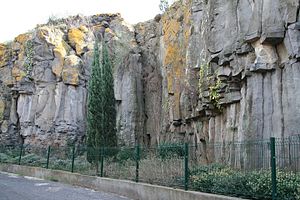Saint-Thibéry (volcano)
Coordinates: 43 ° 22 ′ 58 " N , 3 ° 24 ′ 53" E
The basanite volcanic center of Saint-Thibéry is one of the most recent volcanic phenomena in the Languedoc in southern France , together with the Vias volcano and the Roque Haute volcano . It originated in the Middle Pleistocene around 680,000 years ago.
introduction
The volcanic center of Saint-Thibéry is at the end of a north-south-running series of volcanic centers that reach the Mediterranean from the Cézallier via the Cantal , the Aubrac , the Grands Causses and the Escandorgue in the Hérault department near Agde . It therefore belongs to the Western European rift system . The magma likely penetrated along a north-south trending fault zone and spread to the west over an Old Pleistocene gravel terrace and to the east over the Alluvium des Proto-Hérault .
Occurrence
Between Saint-Thibéry in the north and Bessan in the south lie the Monts Ramus - a series of three quite well-preserved Strombolian volcanic cones 88 ( Ramus 1 ), 84 ( Ramus 2 ) and 61 ( Ramus 3 ) meters above sea level, which are predominantly from volcanic ash and two lava flows . Another lava flow with columnar discharge is in the center of Saint-Thibéry.
The volcanic center of Saint-Thibéry measures around 3.5 kilometers in north-south and almost 3 kilometers in east-west and covers around 10 square kilometers of surface.
description
The Ramus 1 volcano is mined in a large quarry for pozzolana . Several volcanological facies can be seen in this quarry, including the basanite of the central conveying duct , red, yellow and black slag from the Strombolian ejecta and bombs up to one meter in size from the central crater area.
From the main cone Ramus 1 , two significant lava flows of basanite composition emanate. The east current covers an area of 5 square kilometers, the much smaller west current only 0.5 square kilometers. The eastern stream is used by the Roches Bleues quarry . The 13-meter-thick west current, which dips at less than 5 °, is divided into three units - a 1.5-meter-thick lower, columnar colonnade, a 3-meter-thick, layered middle section (the individual layers measure 10 to 30 centimeters) and in the hanging wall an 8 meter thick entablature with a slightly curved, columnar secretion. Except for its surface, the lava flow is practically bubble-free. Its real thickness cannot be determined because the base is not open-minded. This lava flow is mined in the La Vière quarry .
mineralogy
The gray to bluish-gray basanites generally contain phenocrystals of augite , olivine and zoned plagioclase . These are joined by the feldspar representatives leucite , nepheline and analcime .
In the porphyry lava flow directed westwards, Bascou et al. (2005) describe phenocrystals of olivine and augite in the millimeter range with fissure cracks and which occupy a total of 20% of the total volume. The olivine is granular and massive and contains inclusions of chromite . The Augit shows a prismatic habit. The phenocrystals are joined by micro-phenocrystals of plagioclase, augite and, as opaque iron-titanium oxide, titanium-rich titanomagnetite , which can take up to 5 percent by volume. The plagioclase is a labradorite with the composition An 52 , its grain size is 50 to 100 μ. The augite measures only 20 μ and the titanomagnetite 15 μ. Nepheline and glass appear as gusset fillers .
Age
Absolute radiometric ages for the Saint-Thibéry volcano were 680,000 ± 60,000 years BP .
Individual evidence
- ↑ Bascou, J. et al .: Magnetic versus crystallographic fabrics in a basaltic lava flow . In: Journal of Volcanology and Geothermal Research . tape 145 , 2005, pp. 119-135 , doi : 10.1016 / j.Jvolgeores.2005.01.007 .
- ↑ Frechen, J. von and Lippolt, HJ: Potassium-argon data on the age of Laacher volcanism, the Rhine terraces and the ice ages . In: Ice Age and the Present . tape 16 , 1965, pp. 5-30 .

